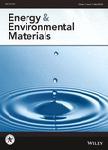Resist Thermal Shock Through Viscoelastic Interface Encapsulation in Perovskite Solar Cells
作者机构:Beijing Inst Technol Sch Mat Sci & Engn Beijing Key Lab Construct Tailorable Adv Funct Mat MIIT Key Lab Low Dimens Quantum Struct & DevicesE Beijing 100081 Peoples R China Beijing Univ Technol Coll Mat Sci & Engn Beijing Key Lab Microstruct & Properties Solids Beijing 100124 Peoples R China Jiangnan Univ Anal & Testing Ctr Wuxi 214122 Peoples R China Peking Univ Sch Mat Sci & Engn Beijing 100871 Peoples R China
出 版 物:《ENERGY & ENVIRONMENTAL MATERIALS》 (能源与环境材料(英文))
年 卷 期:2024年第7卷第6期
页 面:238-245页
核心收录:
学科分类:08[工学] 0805[工学-材料科学与工程(可授工学、理学学位)] 080502[工学-材料学]
基 金:National Natural Science Foundation of China China Postdoctoral Science Foundation [2023 M740167] U21A20172 21975028
主 题:device stability perovskite solar cells stress field surface modulus thermal shock STABILITY
摘 要:Enhancing the lifetime of perovskite solar cells (PSCs) is one of the essential challenges for their industrialization. Although the external encapsulation protects the perovskite device from the erosion of moisture and oxygen under various harsh conditions. However, the perovskite devices still undergo static and dynamic thermal stress during thermal and thermal cycling aging, respectively, resulting in irreversible damage to the morphology, component, and phase of stacked materials. Herein, the viscoelastic polymer polyvinyl butyral (PVB) material is designed onto the surface of perovskite films to form flexible interface encapsulation. After PVB interface encapsulation, the surface modulus of perovskite films decreases by nearly 50%, and the interface stress range under the dynamic temperature field (-40 to 85 degrees C) drops from -42.5 to 64.8 MPa to -14.8 to 5.0 MPa. Besides, PVB forms chemical interactions with FA+ cations and Pb2+, and the macroscopic residual stress is regulated and defects are reduced of the PVB encapsulated perovskite film. As a result, the optimized device s efficiency increases from 22.21% to 23.11%. Additionally, after 1500 h of thermal treatment (85 degrees C), 1000 h of damp heat test (85 degrees C & 85% RH), and 250 cycles of thermal cycling test (-40 to 85 degrees C), the devices maintain 92.6%, 85.8%, and 96.1% of their initial efficiencies, respectively. Viscoelastic PVB material is innovatively designed to form a flexible interface encapsulation. The Surface modulus and interface stress concentration zone are effectively alleviated. The stability breakthroughs in IEC 61215 (thermal treatment at 85 degrees C, damp heat test (85 degrees C & 85% RH), thermal cycling test (-40 to 85 degrees C)) has achieved through the systemic encapsulation by combining internal and external encapsulation. image



